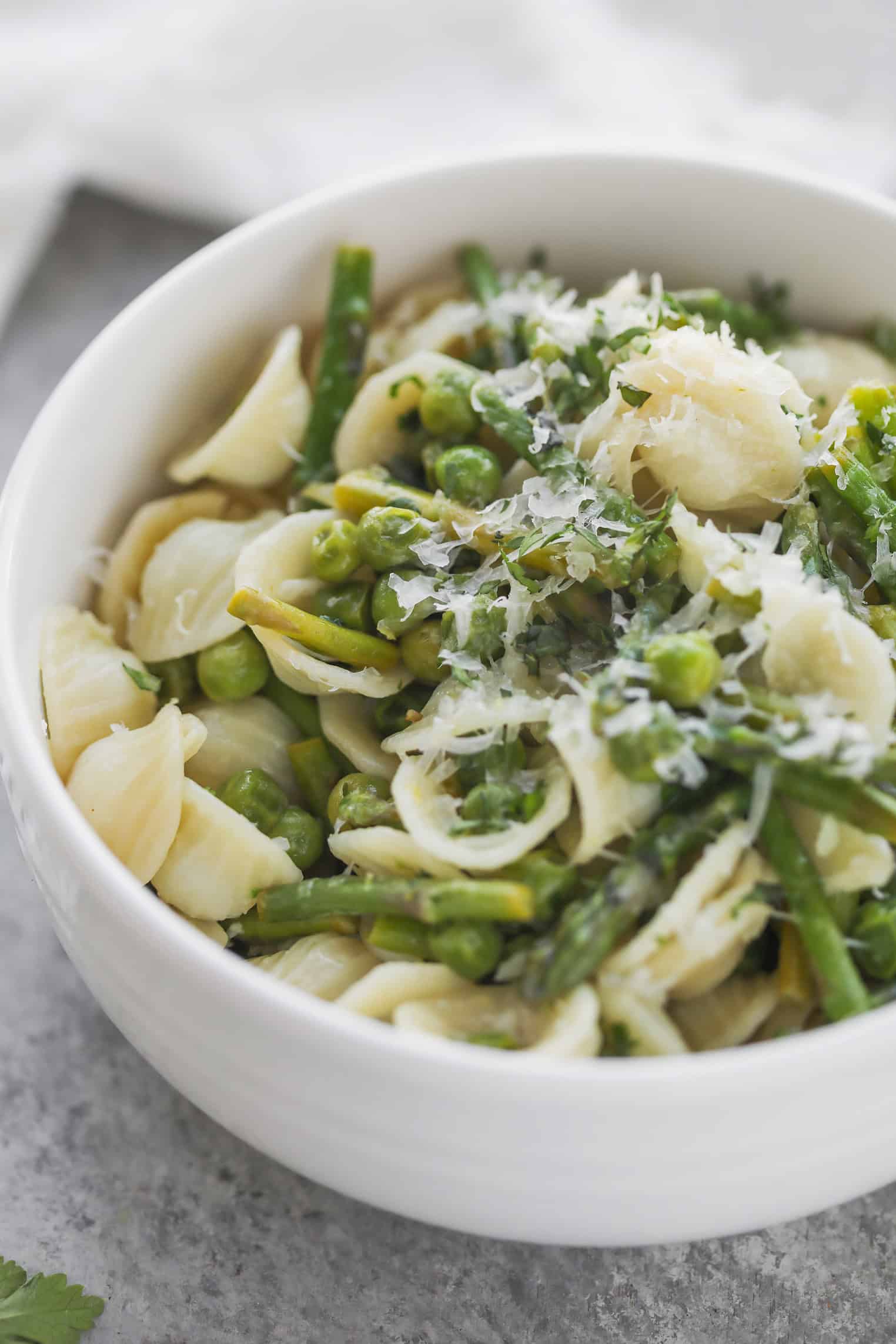Pea and Asparagus Pasta
This pea and asparagus pasta is simple enough for a weeknight dinner but fancy enough to serve for company.
It’s bursting with spring flavors, like peas, asparagus, fresh herbs, lemon, and plenty of parmesan cheese for a delicious, show stopping dinner.
An easy pasta that celebrates two of my favorite spring vegetables: peas and asparagus.
This pea and asparagus pasta is inspired by one of my other favorite asparagus recipes, my spring vegetable gnocchi. I love the combination of lemon, parmesan, pea and asparagus there and knew it would work in this pasta version with orecchiette.
This pasta recipe really celebrates all things spring, and I love making it this time of year as we transition from the dreary days of winter to the promise of spring.
See below for more tips and step-by-step directions, or click below to head straight to the recipe.
Why I love this recipe
Pea and asparagus together with tender pasta, what’s not to love? This pea and asparagus pasta is simpler than my pasta primavera recipe but just as delicious.
I find that this recipe offers the perfect balance between comfort food and fresh, vibrant food. The peas’ sweet, slightly earthy flavor perfectly complements the asparagus’s subtly bitter notes. The addition of lemon, parmesan, and garlic enhances both of these flavors.
As a dietitian, I love that a bowl of this pasta includes two servings of vegetables with 20 g of protein per serving. Yes, pasta contains protein– a single cup has 8 g.
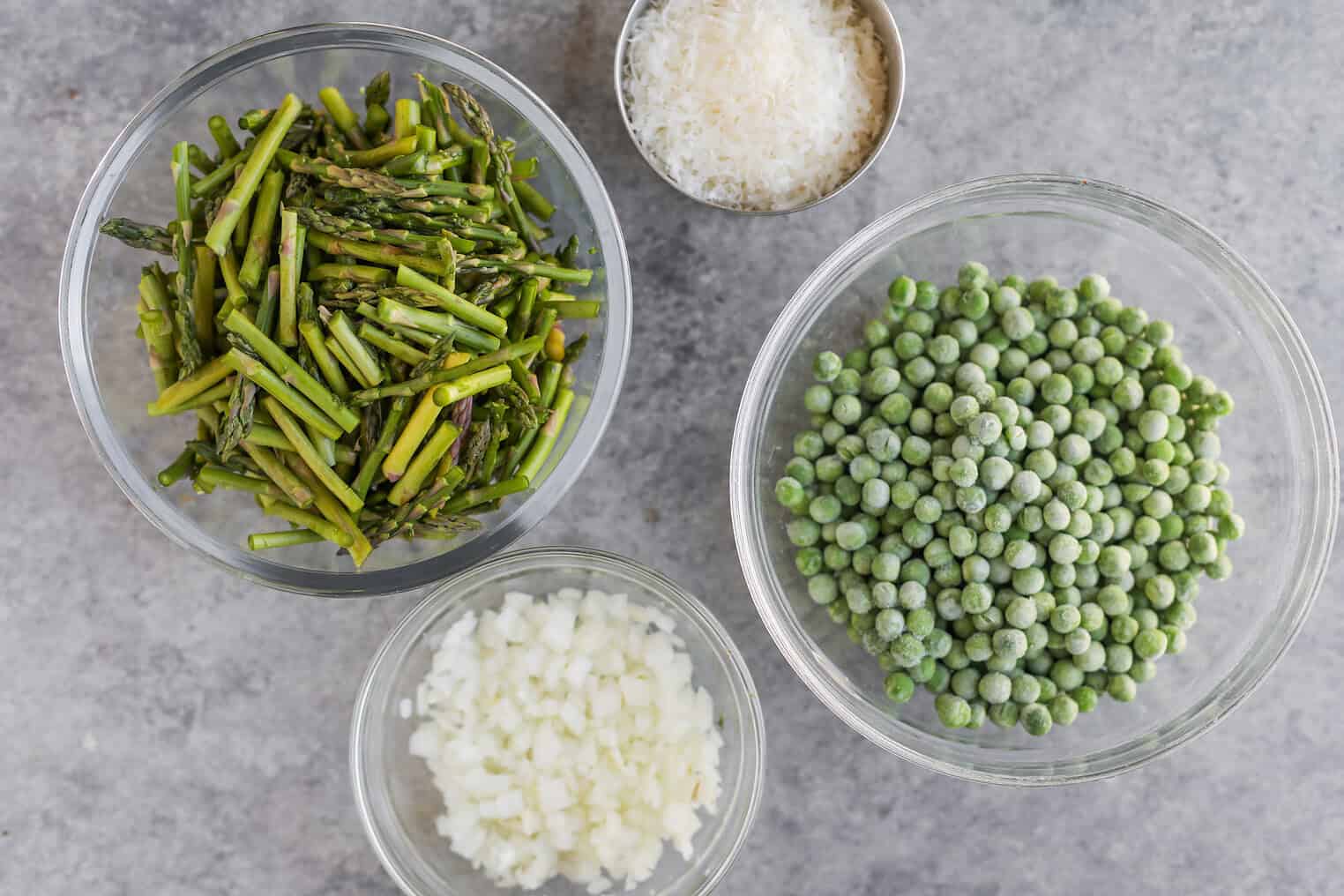
Ingredients
You’ll need to remove the woody ends of the asparagus stalks before cooking, and there are a few ways to do this. You can see where the asparagus stalk transitions from a vibrant green to a paler, often whitish, color. This paler section is typically the tougher, woody end– once you find it, cut it off.
What I do is snap off the ends to ensure that I am removing the woody end from all of the stalks. To snap, gently bend the asparagus spear, and it will naturally break where the tender part meets the woody end.
Once I’ve snapped a few ends off, I line up those along with the rest of the asparagus and chop the ends off. I like this method as it ensures I’ve identified the woody ends while saving time. Thicker asparagus spears may require more of the ends to be removed than thinner ones.
If you see fresh shelled peas at the store, grab them! Otherwise, frozen peas work just fine.
Substitutions
As shelled peas are harder to find than frozen ones, I’ve written the directions for this recipe using frozen peas. However, if you plan on using fresh peas, then you’ll use the same amount (3/4 cup) and blanch them along with the asparagus in step 1.
To make this recipe vegan, then use vegan parmesan cheese or omit. If you are using storebought cheese, then my favorite brand is Violife. I’ve tried several different vegan parmesan brands and this one is the best in my opinion. Get the wedge, not the preshredded cheese.
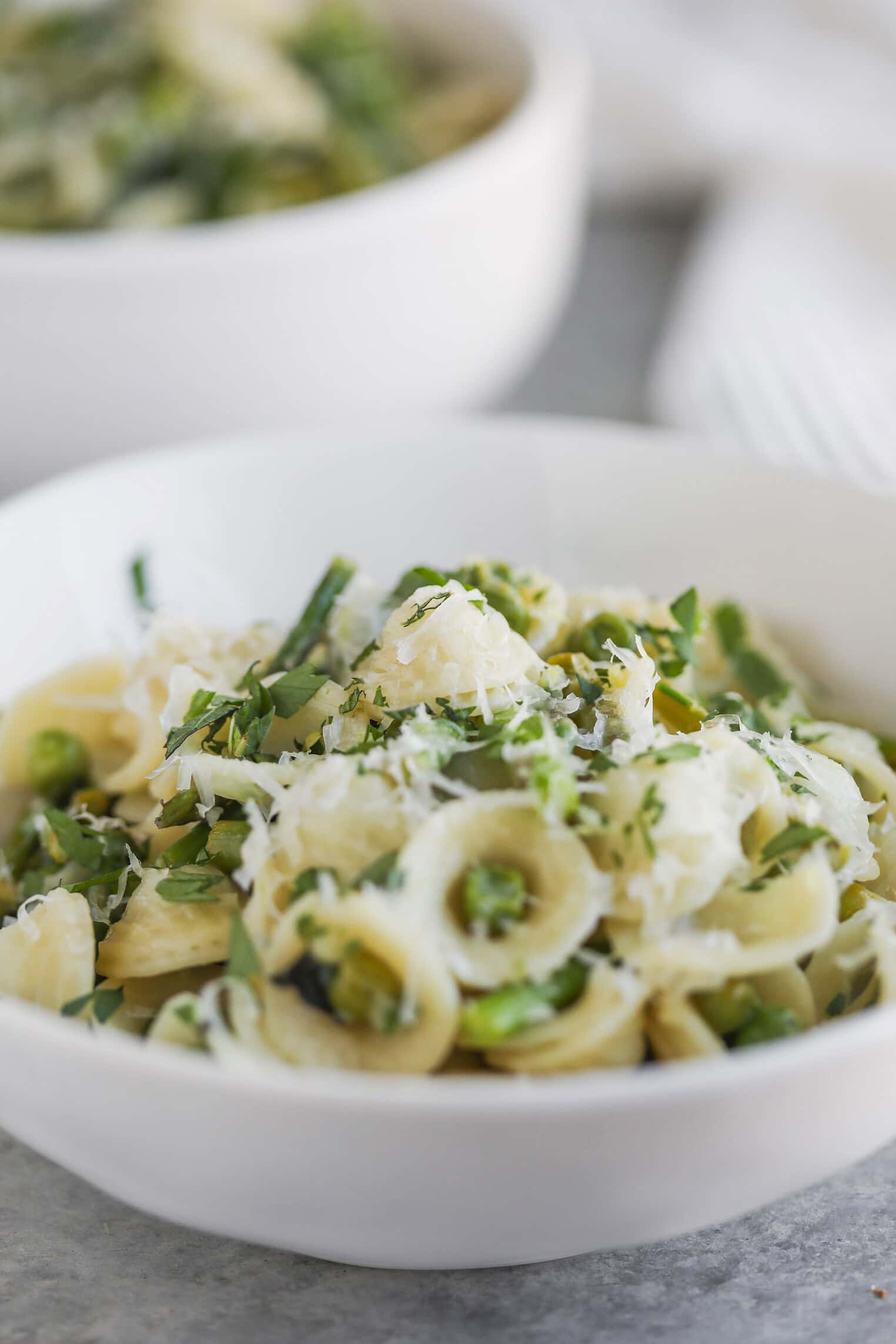
How to Make
Prep the asparagus first, as this pasta sauce comes together fairly quickly. I like to gather all of my ingredients before cooking so I’m not spending time prepping the recipe while I cook.
Blanch the asparagus
Bring a large pot of salted water to a boil. Blanch the asparagus by adding the asparagus to the pot, cooking for 1-2 minutes until just bright green in color and then remove and place them immediately in a bowl of ice water to stop cooking. If you are using fresh peas, add them here.
I recommend going by color and not time, as it will depend on how thick or thin your asparagus is. Thin asparagus, like the ones in these photos, will cook faster. The blanching is mainly for appearance and color, as cooked asparagus can become muted and unattractive. The blanching keeps the bright green color, which is why I included it.
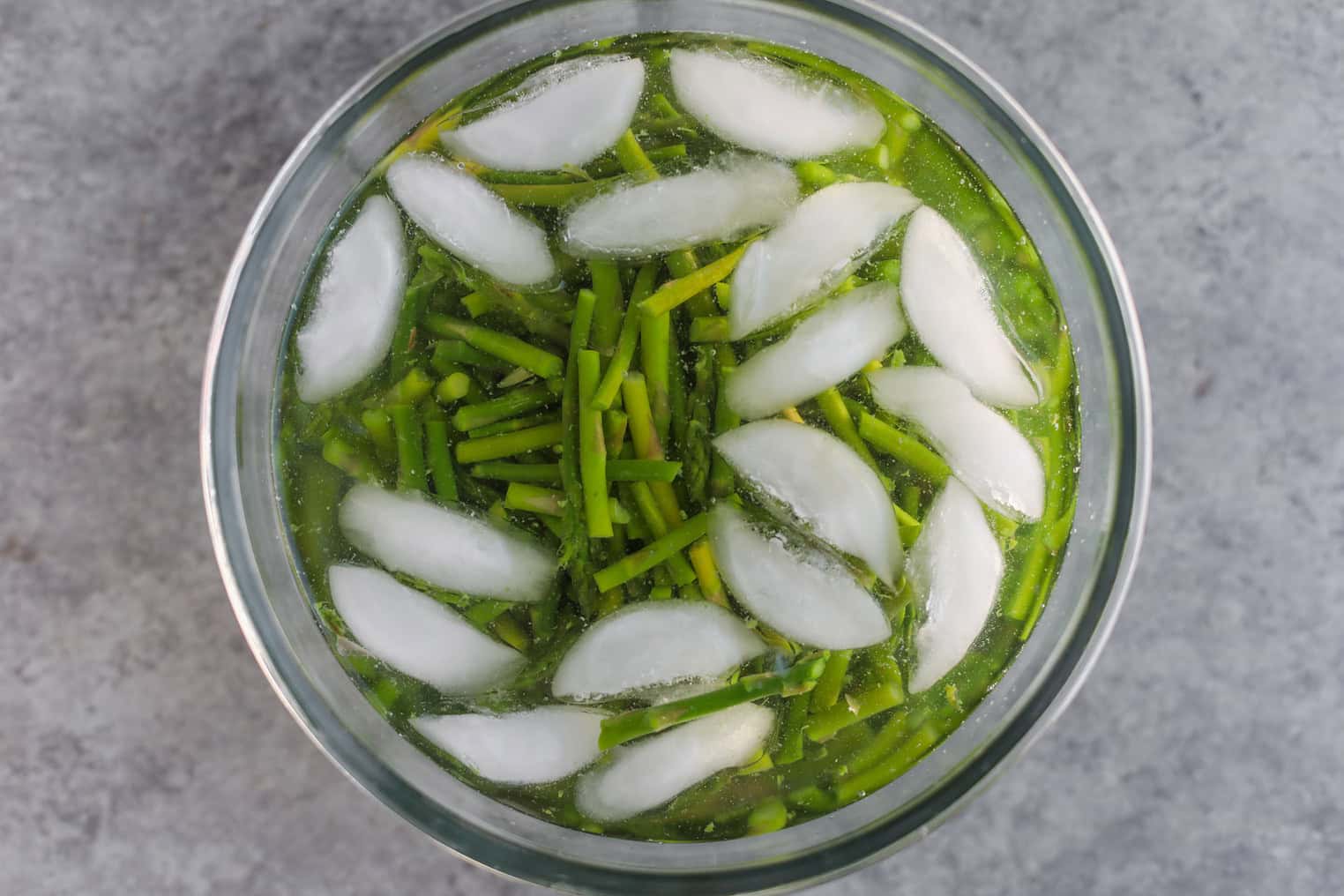
Cook the Pasta
Add the pasta to the same pot that the asparagus was just in and cook until al dente. I use a spider or a strainer to remove the asparagus so that I can use the same water to cook the pasta. This prevents waste and is faster!
Drain, reserving about 1 1/2 cups of pasta water. This is crucial to make the sauce so don’t skip it! Regular water isn’t the same as pasta water as pasta water contains starches that help thicken the sauce and allow it to cling to the pasta.
Cook the onion
Saute the onion in olive oil until tender and softened. This should take about 10 minutes, stirring often to prevent any burning. If my onion is sticking too much to the skillet, then I will add a little more olive oil.
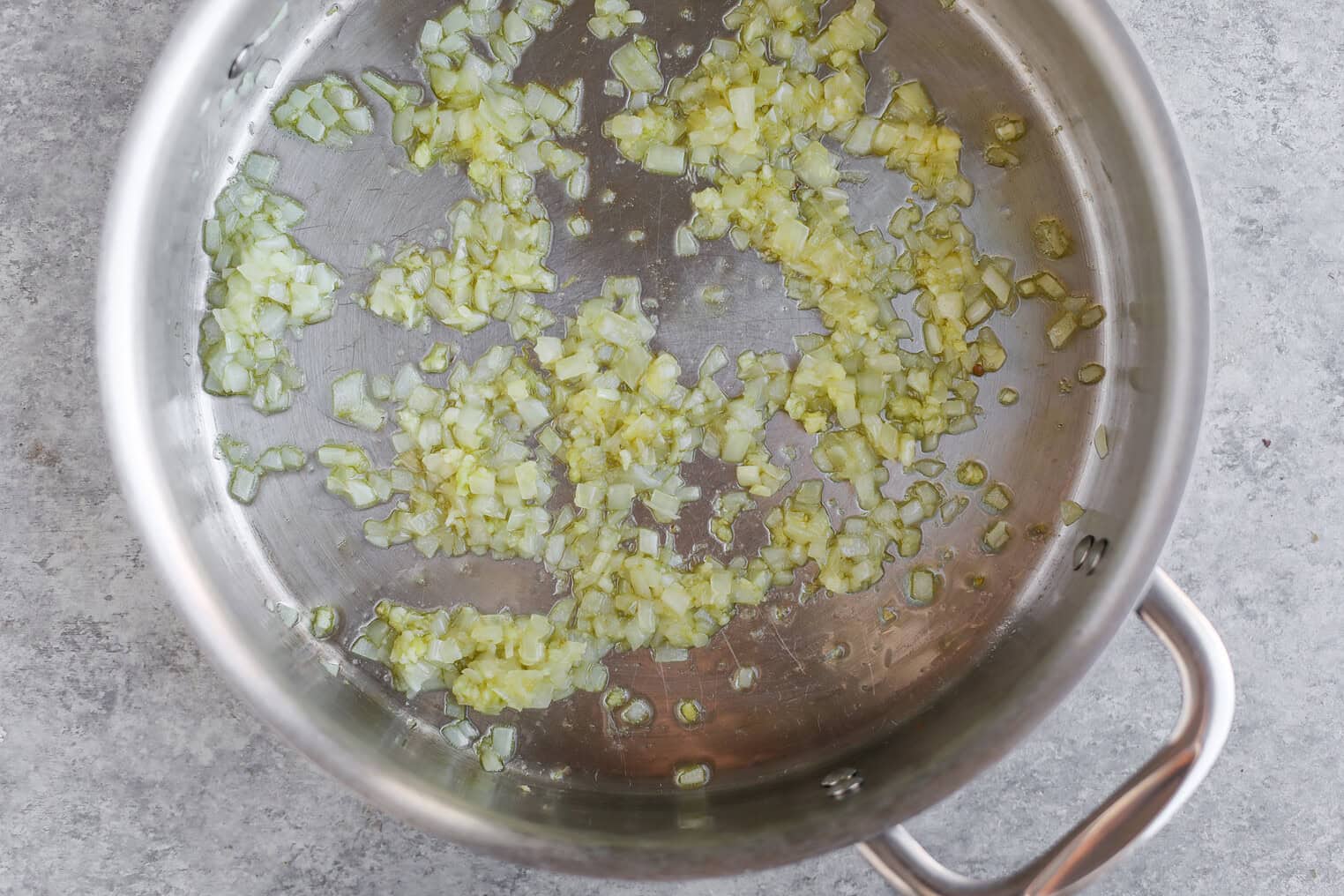
Add the vegetables
Add in the blanched asparagus, peas, and garlic and cook, stirring often, for just a few minutes until the peas should be bright green and just beginning to soften.
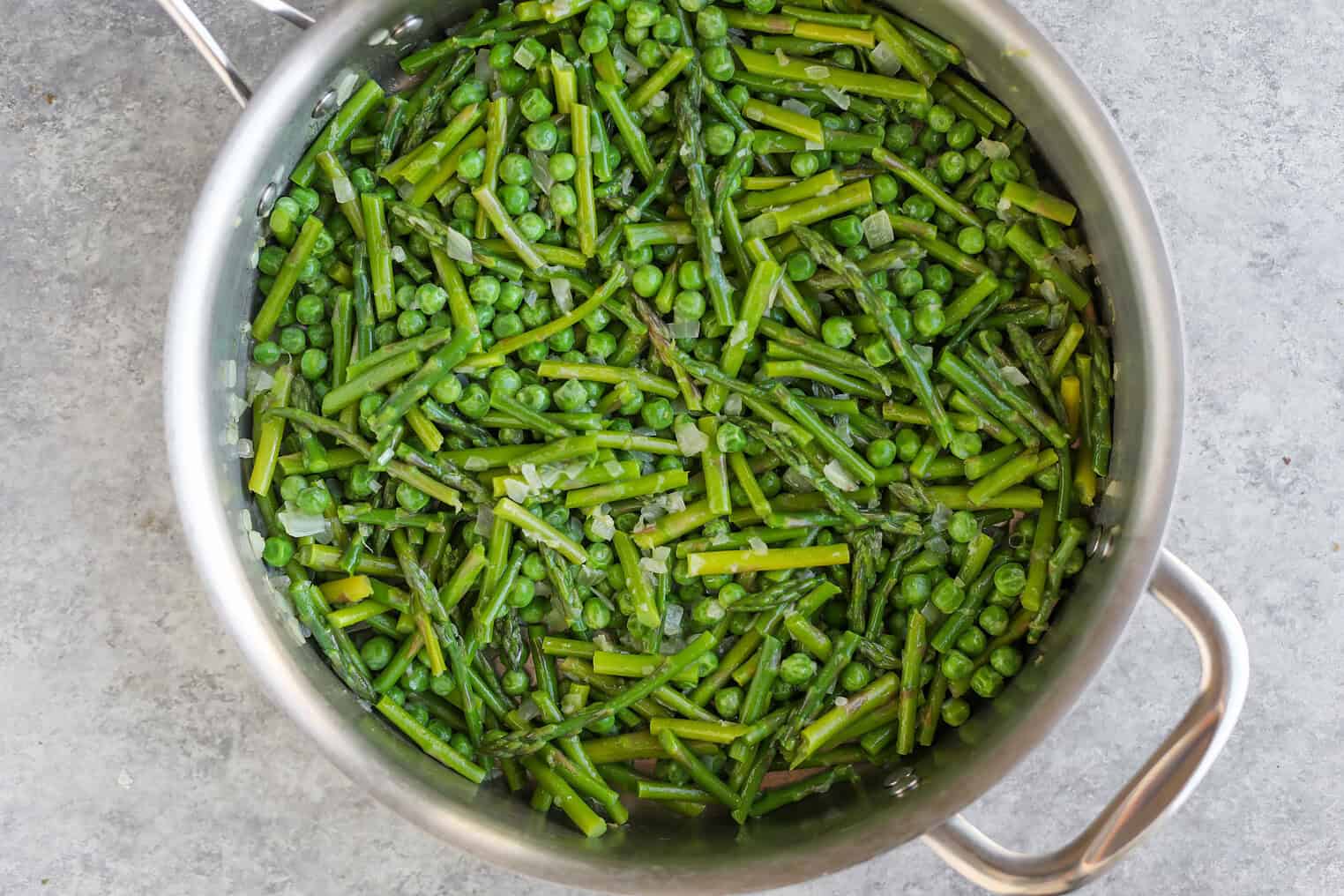
Build the Sauce
Using pasta water is the secret to creating a glossy, restaurant-worthy pasta. Add in 1 cup of reserved pasta water to the skillet and simmer until reduced by half and a sauce begins to form, about 4-5 minutes.
Once your sauce has thickened and reduced, add in your al dente pasta, the lemon juice, zest and another 1/4 cup of the reserved pasta water. Toss continuously until the noodles are coated with the sauce, adding a little more reserved pasta water if it’s too dry.
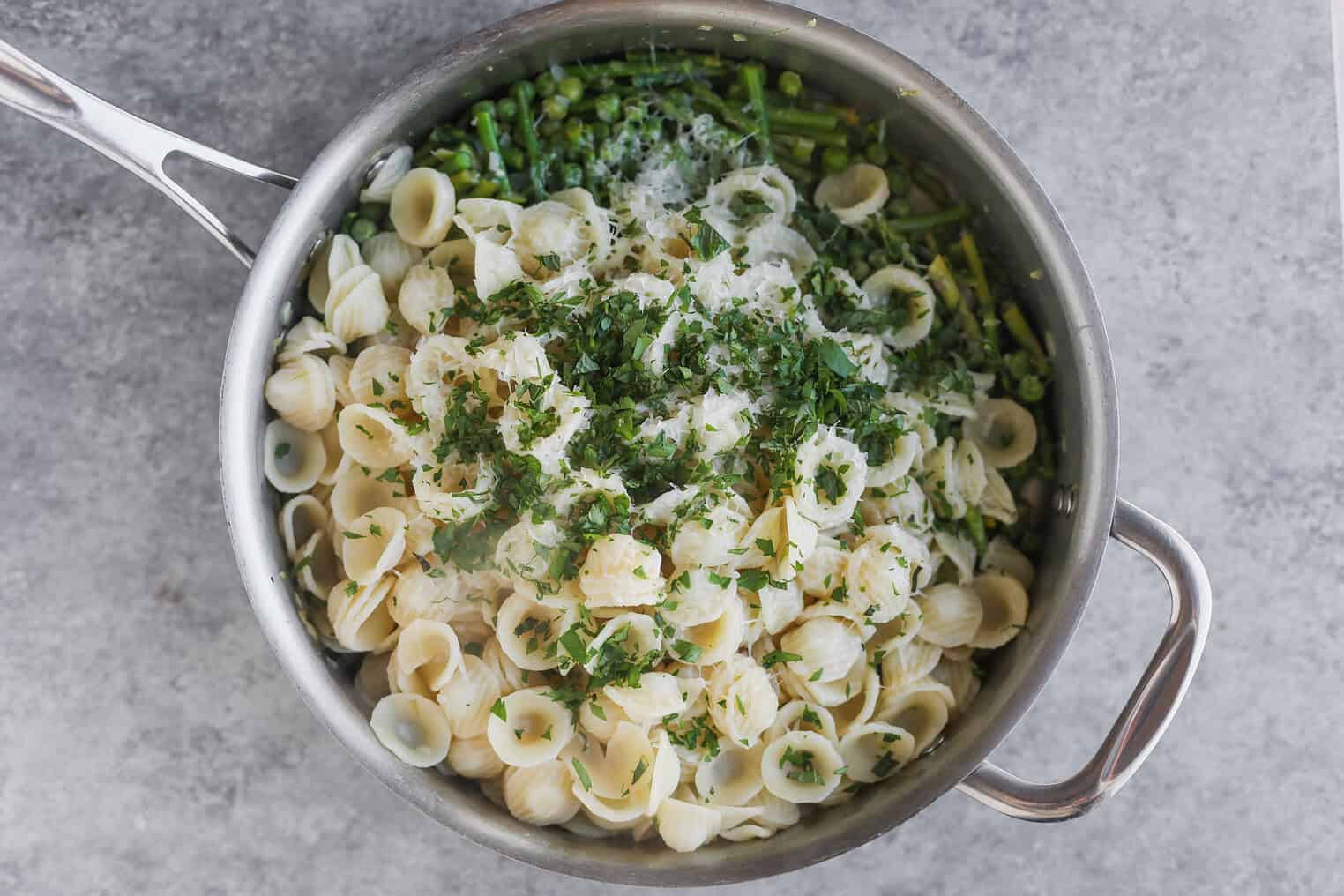
Add the cheese
Remove the skillet from heat and add in the parmesan cheese. I like to start with 1/4 cup first so the cheese doesn’t clump. Add the cheese and then toss quickly; this helps distribute the cheese evenly into the pasta.
Then, I add another 1/4 cup and rapidly toss again, then continue until my desired taste and consistency is reached. I usually do about 3/4 cup of grated fresh parmesan in total, but you can always add more or less.
The parmesan adds a lot of umami flavor along with saltiness, so if you do decide to omit it, you may need to adjust the balance of flavors by adding more salt, parsley, and lemon to taste.
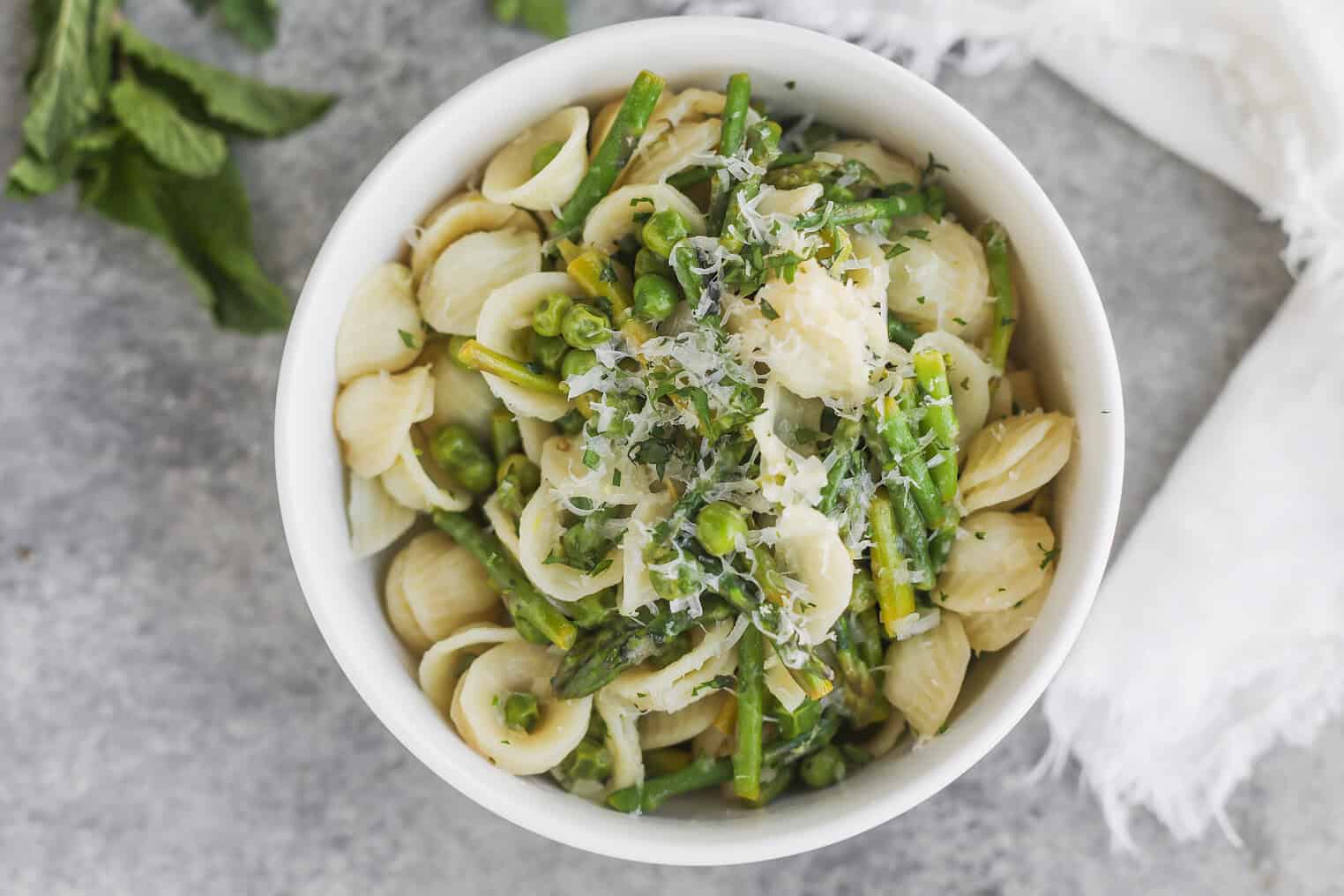
Chef Tips for Success
Timing is key for this pea and asparagus pasta recipe. This is why I like to prep all of my ingredients ahead of time so that I can quickly build the sauce when ready.
Overcooked vegetables will become mushy and lose their flavor. Take the time to snap off the woody ends of the asparagus as they will never become tender. If you have various sized asparagus, then you can consider adding the more tender tips slightly later than the thicker stalk pieces so they cook evenly. I have a full tutorial if you are new to cooking asparagus and want more tips.
Cook the pasta al dente, meaning it should still have a slight bite. This prevents it from becoming overly soft when combined with the vegetables and sauce. I check the pasta about a minute before it says to according to the package so make sure that I’m not overcooking.
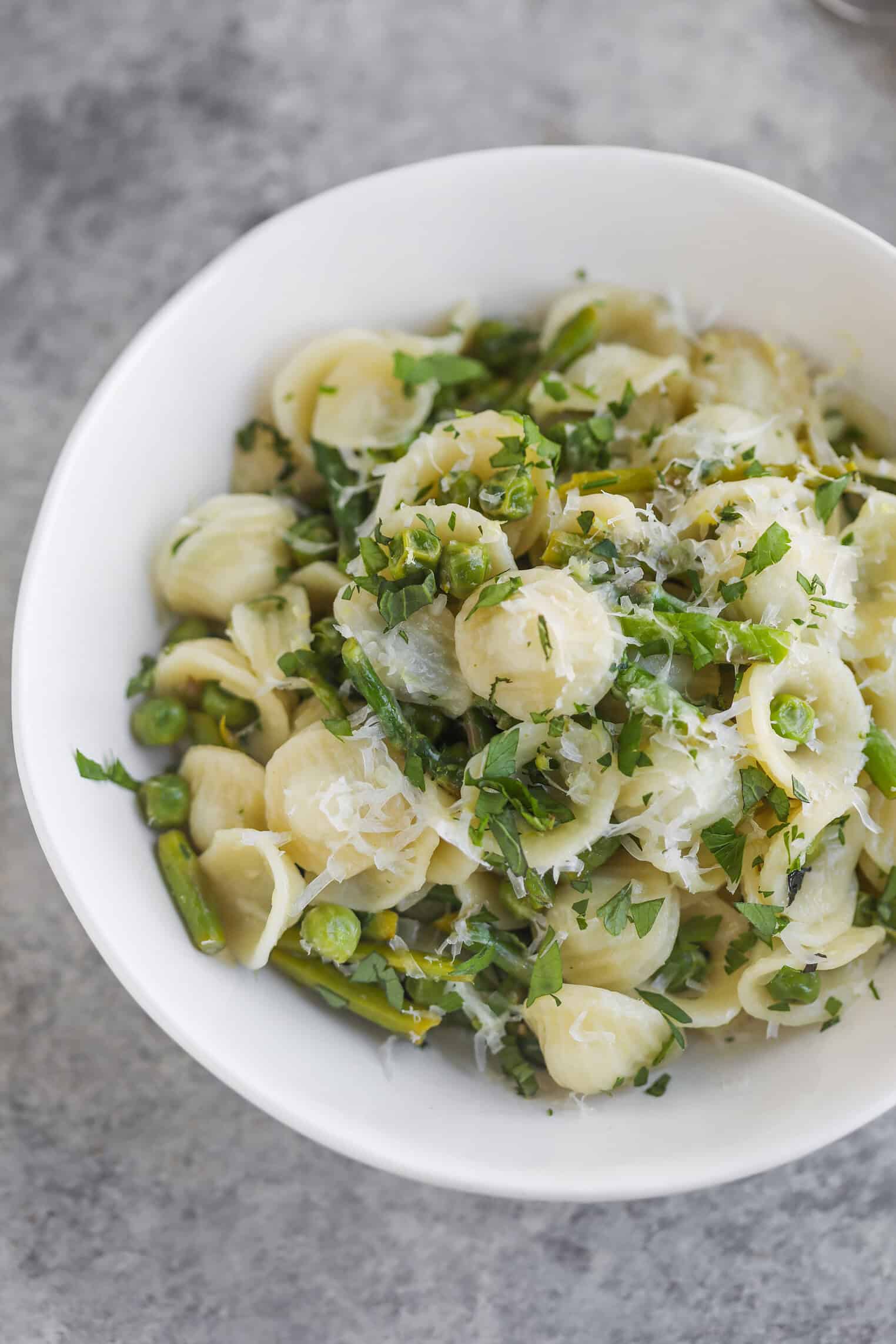
What to serve with
This pea and asparagus pasta is a peak spring recipe, which means that I like to serve it alongside other spring recipes, like my kale caesar salad or my shaved asparagus salad.
I enjoy the combo of pasta and salad together for a variety of textures and extra vegetables, but this pasta is hearty enough to be served on its own.
Frequently Asked Questions
What pasta shape works best?
Choose a pasta shape that holds sauce well for this pea and asparagus pasta recipe. I used orecchiette as this shape helps to cradle the delicate peas and parmesan sauce, but penne will also work.
Can I use frozen peas and asparagus?
Yes, I call for frozen peas in this recipe for ease. If you want to use frozen asparagus, they don’t need to be blanched first, just add them right to the skillet with the pasta and cook through.
Why do I need to reserve the pasta water?
The starchy pasta water helps to thicken the sauce and allows it to cling to the pasta.
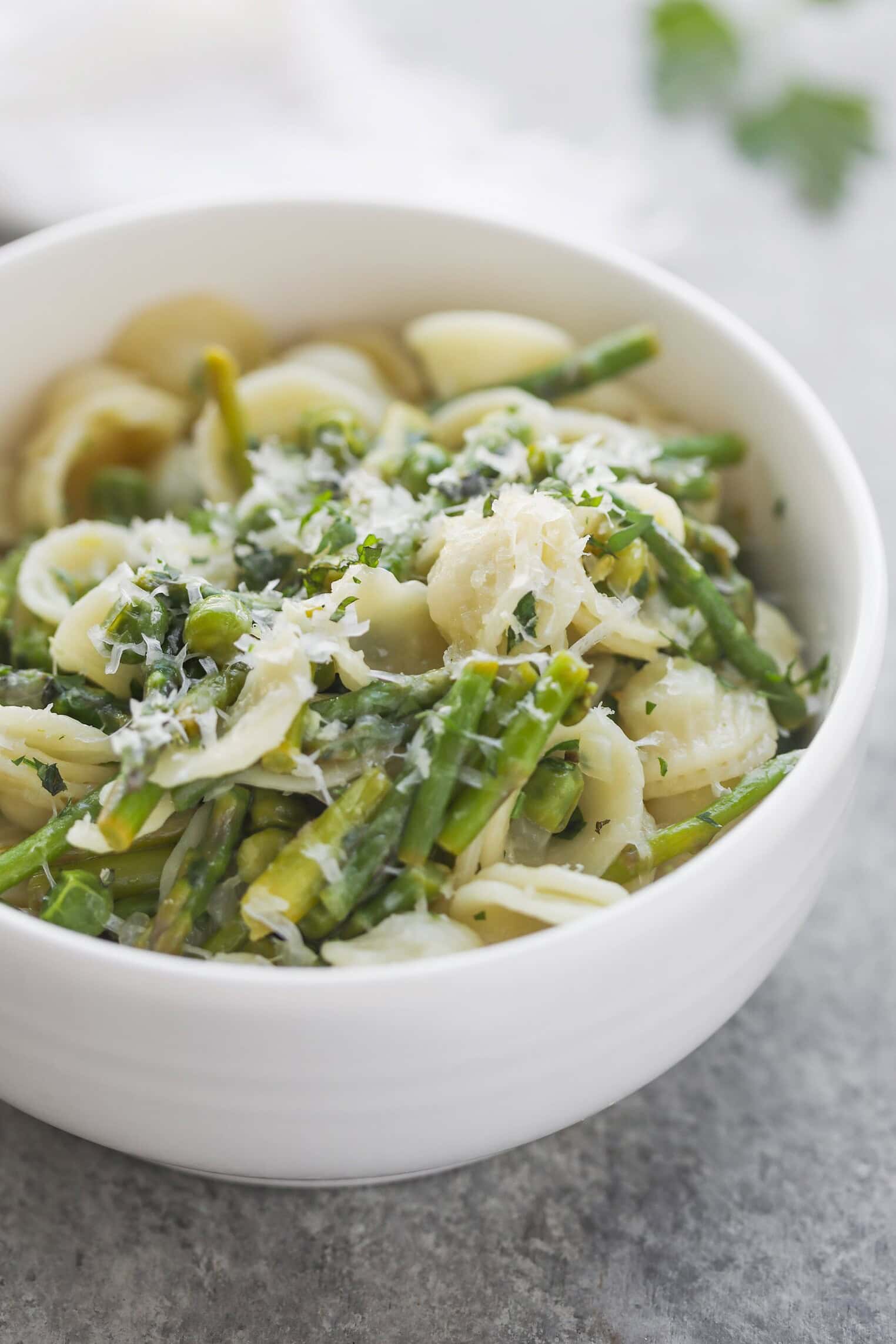
Storage Notes
This pea and asparagus pasta tastes best right when you make it, but if you have any leftovers, store them in an airtight container in the refrigerator for 3-4 days.
When reheating, add a splash of water, broth, or milk to prevent the pasta from drying out. I like adding more lemon juice and parmesan after reheating to brighten the flavors.
More Asparagus Recipes
- Asparagus Risotto
- Vegan Eggs Benedict with Asparagus
- Spring Panzanella Salad
- Grilled Vegetable Pasta Salad
- Pea and Asparagus Soup
If you try this pea and asparagus pasta, make sure to come back to leave a comment and a rating. Your feedback helps other readers, and seeing you make my recipes makes my day!

Pea and Asparagus Pasta
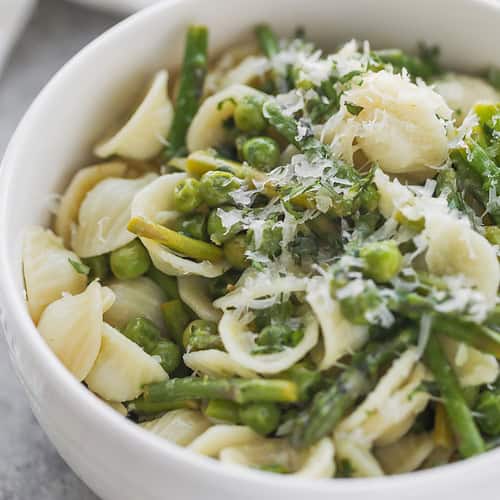
Ingredients
- 1 bunch asparagus, woody ends removed and cut into 1-inch pieces
- 12 ounces orecchiette pasta1
- 1/4 cup olive oil
- 1/4 cup finely chopped white or yellow onion
- 1/2 teaspoon salt
- 3/4 cup frozen peas
- 4 garlic cloves, minced
- 1 tablespoon fresh lemon juice + 1/2 teaspoon lemon zest
- 3/4 cup grated parmesan cheese
- 1/4 cup chopped parsley2
Instructions
- Bring a large pot of salted water to a boil. Blanch the asparagus: add the asparagus and cook for 1-2 minutes until just bright green in color. Using a spider or a slotted spoon, quickly remove the asparagus and place them immediately in a bowl of ice water to stop cooking. Drain and set aside.
- To the same pot of water, add the pasta and cook until just al dente according to package directions. Drain, reserving 1 1/2 cups of pasta water.
- In a large skillet, heat the olive oil over medium heat. Add the onion and salt, and cook until tender, about 8 minutes. Add in the blanched asparagus, peas, and garlic and cook, stirring often, for 1-2 minutes. The peas should be bright green and just beginning to soften.
- Add in 1 cup of reserved pasta water to the skillet and simmer until reduced by half and a sauce begins to form, about 4-5 minutes. Add the cooked pasta, lemon juice, zest, and an additional 1/4 cup of reserved pasta water to the sauce. Toss continuously until the noodles are coated with the sauce, adding a little more reserved pasta water if it's too dry.
- Remove from heat and add in 1/4 cup parmesan cheese; toss quickly so the cheese doesn't clump, then add in another 1/4 cup and toss again rapidly, then continue with the rest of the cheese until desired taste and consistency is reached– I usually do 3/4 cup, but you can add more!
- Stir in chopped parsley, then taste, adding more salt/pepper as desired and serve.
Notes
- I find that 12 ounces is the perfect amount for 4 when adding in the extra veggies; if you want to use the full pound, then increase the sauce to 1/3 cup olive oil, 1/3 cup finely chopped onion, 1 1/2 cups grated cheese and 1 3/4-2 cups reserved pasta water
- I love mint and asparagus together so if you have it, I also like to add in a tablespoon or two of finely chopped mint.


